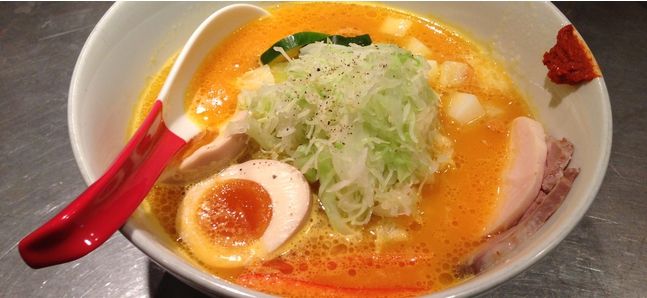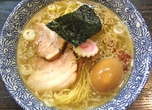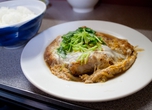
麹町『ソラノイロ』
Posted: Tue Dec 31 2013
Based on data collected through the daily fieldwork of our ever-vigilant ramen hunters, we've chosen the following 20 ramen shops to represent 2013. On the list of shops worth paying a year-end visit to are places that have helped establish recent industry trends like niboshi (dried sardines), tori-paitan (chicken-flavoured soup), and chintan (clear broth), as well as eateries whose offerings hint at the trends to come in 2014 and beyond. The list is rounded off by can't-miss old-timers that have earned their reputations as true classics. Start the new year by treating yourself to a city-wide ramen tour.
Sorairo
'Veggie soba' that captures women's hearts
The main menu at this Kojimachi shop is twofold: 'Chuka (chinese) soba' (¥750), a dish with clear soy sauce broth that blends meat and seafood flavours, and 'Special Veggie soba' (¥1000), which includes a soup made of carrot puree, paprika-flavoured noodles, and generous vegetable toppings. Defying the conventional concept of the greasy delicacy that is ramen, this healthy variety has proven especially popular with Tokyo's ramen-loving ladies.
Read more
Japanese Soba Noodles Tsuta
Shoyu, shio, and miso - all high quality varieties
This Sugamo shop offers one of the city's best examples of 2013's tanrei (signifying a clear, simple taste) trend. Be it salt-, soy sauce-, or miso-based soup, all three varieties maintain a high quality: the soup, noodles, and other ingredients are all wonderfully balanced in each dish, and they all leave a first-rate aftertaste.
Read more
Ramen Nagi Shinjuku Niboshi Shinjuku Golden-gai
The richest niboshi soup in the city
Niboshi (dried sardine) soup was one of the top ramen trends of 2013, and this shop offers the richest niboshi ramen in the city. The soup, made from over 20 varieties of dried sardines and cooked for over half a day, is nothing less than a masterpiece. Those of you worrying about your waistline, be warned - this taste is addictive.
Read more
Sansanto
Gentle, MSG-free double soup
Going against the standard custom of hard-nosed gyokai-tonkotsu (seafood and pork-based soup) shops, this Higashi-Jujo eatery offers MSG-free ramen. The rich soup is made from a seafood stock of dried mackerel and sardines added to a base of venison, whole chicken, and pork bones. Even as shops offering such 'double soups' are on the increase in the city, this one maintains a unique presence.
Read more
Motenashi Kuroki
All-new salt and miso ramen
Although it's only been open for two years, this popular shop is one of the best in Akihabara. The menu has two main attractions: the first is the shio ramen with its blend of six different salts, and the other is the miso ramen, which consists of a miso sauce with sesame and almonds - a unique, novel choice that rises above the standard. Backed up by its owner's experience in a traditional Japanese restaurant, this shop continues to offer a superb menu.
Read more
Men-ya Kissou
An all-star shop that survived the end of the tsukemen craze
Of all the seafood tsukemen shops that popped up in the city during the recent and very temporary noodle-dipping craze, Kissou maintains an unparalleled status. The tonkotsu-seafood-soy sauce-based soup is well balanced, achieving just the right amount of both richness and mildness, and there's certainly nothing wrong with the noodles either. The dish is made with great care overall, having just the perfect amount of sweetness mixed into the gyokai-tonkotsu (seafood and pork) flavour.
Read more
Hototogisu
A clear soup to savour all the way to the last drop
Hototogisu's creations feature a clear pork-based soup mixed with stock made from a generous amount of clams - you'll want to drink up every last drop of this rich, taste bud-pounding soup. On the main menu are shio (salt, ¥800) and shoyu (soy sauce) soba (¥750). White truffles and salted lard have been added to the clam-based soup for even more flavour, making it very pleasing to the eye as well.
Read more
Guchoku
For a full impact of 'tonkotsu'
Although it's a bit out of the way, the queue at this popular shop is endless. Try the tonkotsu ramen (¥650): extremely rich but also just mild enough that you can easily down all the creamy soup. The 100-percent pork-based soup, made from carefully cooked pig heads and feet, goes very well with the straight hand-made noodles. This shop has strived to stay faithfully on the righteous path of tonkotsu while still maintaining its own style - a stance that brings fascinating rewards.
Read more
Seitoku
Mid-sized noodles make the best tsukemen
The mid-sized tsukemen noodles here, made from bread flour each morning by the owner himself, are a perfect match for the ultra-rich dipping sauce, crafted from fragrant dried bonito and sardines which are mixed with a meat-based stock and shrimp oil. The addition of shrimp oil makes for a nice accent and creates something that's more than just your average bowl of gyokai-tonkotsu (seafood and pork) ramen.
Read more
Marutama
The trailblazer of 'tori-paitan'
This Ryogoku eatery is the trailblazer of the tori-paitan (white chicken-based soup) trend. A special salt sauce is added to a base of chicken soup, and with just the right amount of salt and chicken flavours, this ramen goes down easier than you'd think. We recommend the 'Aosa ramen' (¥850), made with Ise-produced aosa algae.
Read more
Niboshika Ramen En
The niboshi king of Hachioji
Located close to Hachioji Station, this is the city's most famous representative of 2013's niboshi (dried sardine) trend. The 'Niboshi ramen' (¥700), served with a soup made from sardine, chicken, and kelp stock, is the real deal. Topped simply but deliciously with green onions, bamboo shoots, soft-boiled egg, and perfectly textured chashu pork slices, this dish is by itself worth a trip to the far west.
Read more
Iekei Ramen Katsuraya
Best family-owned shop in the city
This homely haunt makes ramen of such high quality that many claim it is the best of the many Yokohama-born family shops in the city. The rich pork- and chicken-based soup combines with noodles that are just a little on the soft side, and with thick, tender chashu pork (so good you'll want seconds), spinach, and nori to create a complete, unique taste. The staff goes all-out when it comes to quality control, even going as far as to adjust the flavour of each bowl of soup ordered.
Read more
Hanamichi
Miso lovers head to Nogata
The 2013 version of this Nogata shop's miso ramen (¥750), made with white miso, garlic, and lard, and cooked in a soup crafted from pork, chicken and vegetable stock, is rich but not too strong: a taste that doesn't get old and is well received by all ages (Hanamichi welcomes a lot of repeat customers). 2013 also saw the addition of a new special to the menu - the 'Sapporo miso ramen" (¥800) is served only on Tuesdays.
Read more
Daiki
No craze can touch this famous taste
This Yushima joint takes pride in its 'Uetori soba' (¥850). The soup, prepared by the owner who spent 20 years studying Japanese cooking, is made from seafood and chicken necks, producing a taste so incredibly refined and delicate that you'll want to drink it up to the last drop. The long-beloved taste of this famous shop has kept its muster despite the proliferation of niboshi-focused shops during the craze of 2013.
Read more
Senrigan
Inspired by Jiro
Inspired by Tamachi's renowned Jiro, the 'Pork ramen' (¥850) here is only for the big eaters, as it comes packed with super-thick, wavy noodles, three slices of voluminous chashu pork, and piles of bean sprouts and cabbage. In addition to the usual options of garlic and vegetables, the 'kara-age' topping (bits of fried tempura batter flavoured with chili pepper) is also popular.
Read more
Shinagawa
Simple chuka soba from a trend-setting shop
The main offering here is simple chuka soba, which they say aims for a 'classic taste that doesn't get caught up in trends'. The soup is a blend of seafood and meat, including pork and carefully selected hinai-jidori chicken, and goes extremely well with the delicate, refined taste and smooth texture of the homemade medium-thin noodles. The simple toppings include chashu pork slices, green onions, and bamboo shoots. This exquisite but simplistic dish made this joint the talk of 2013.
Read more
Yamaguchi
Ramen with a concentrated chicken taste
On the menu at this Takadanobaba favourite are 'Oigatsuo Chuka soba', with kelp and bonito stock mixed into a chicken base; and 'Tori soba', with a soup made from generous portions of chicken meat and bones. The unique feature of the 'Oigatsuo' is its strong bonito-flavoured, soy sauce-based soup, while the 'Tori' is distinguished by its flavour- and fragrance-packed soup. The chefs are particular about using quality stuff like hinai-jidori chicken, helping to lift Yamaguchi over its competition.
Read more
Kagari
This is where the queues are in Ginza
Crowds started gathering around it as soon as this shop appeared in an alley in Ginza in March. The focus here is on the twin soup menu, which includes the thick, chicken-based 'Tori-paitan soba' (¥850), and the meat- and niboshi-based 'Niboshi shoyu soba' (¥800). Particularly the former is worth a try: the overall effect is mild, the noodles and toppings are well balanced, and you can even add condiments like fried onions or ginger.
Read more
Chuka Soba JAC
Tokushima ramen with a Tokyo touch
This Tokushima-style shop, opened in September 2012, makes a delicious soup consisting of soy sauce and a rich pork base, with other ingredients including separately cooked sukiyaki-style pork, boiled eggs, menma bamboo shoots, and bean sprouts. Add a free egg and rice to the 'JAC soba' (¥900) for a true Tokushima experience.
Read more
Kujira Shokudo
A clear soup for the ages
Opened in September 2013, this Higashi-Koganei shop has slowly but surely built up a noteworthy following. The basics on the menu are 'Shoyu ramen' and 'Shio ramen', dishes that combine wavy noodles and a seafood-based soup with added meat and shiitake mushrooms, and also include basic toppings like thin menma bamboo shoots and chashu pork for a good balance of fatty and meaty flavours. The product here achieves such a high level of perfection that it's no exaggeration to call Kujira the best representative of the chintan (clear soup) trend in the city.
Read more
Tweets
- About Us |
- Work for Time Out |
- Send us info |
- Advertising |
- Mobile edition |
- Terms & Conditions |
- Privacy policy |
- Contact Us
Copyright © 2014 Time Out Tokyo





































Add your comment